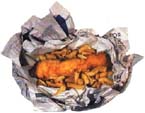|
|
Cuisine Glossary
| You have reached our International Cuisines and information on all aspects of a countries cuisine.
We will try to explain the culture, significant influences, climate, and other factors that have come together to create a distinct style. For example: Spanish, Mexican or Japanese. |
British Cuisine
 |
British cookery has been much maligned and has improved dramatically in the restaurants and country inns in the past decade. Traditional British cuisine is substantial, yet simple and wholesome. The Brits have long believed in four meals a day. Their fare has been influenced by the traditions and tastes from different parts of the British Empire: teas from Ceylon and chutney, kedgeree, and mulligatawny soup from India. The British nanny has also played a role with her nursery favorites, such as Bread and Butter Pudding, Spotted Dick, and Treacle Tart. Roast beef with Yorkshire Pudding and Plum Pudding are important contributions to international cuisine. Other popular dishes include Cornish Pasties and Beefsteak and Kidney Pie. The English developed a line of spicy sauces including ketchup, mint sauce, Worcestershire sauce and deviled sauce. Today there is an emphasis on fine, fresh ingredients in the better restaurants and their markets offer countless worldly items. Salmon, Dover sole, prawns, game, and lamb are choice items. Wild fowl and game are specialties. Among English cakes and pastries, many are tied to the various holidays of the year. Hot Cross Buns are eaten on Good Friday, Simnel Cake is for Mothering Sunday, Plum Pudding for Christmas, and Twelfth Night Cake for Epiphany. Local delicacies include Bath Buns, Chelsea Buns, Eccles Cakes, and Banbury Cakes. Cheeses are choice regional specialties, including Stilton, farmhouse cheddars and Cheshire Cheese. Source: by Lou Seibert Pappas |




